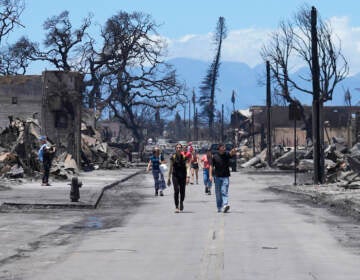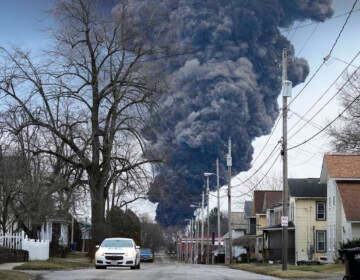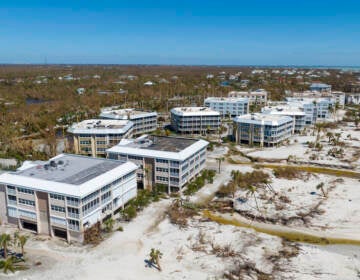Hurricane Florence, ‘an uninvited brute,’ brings floods, causes at least 4 deaths
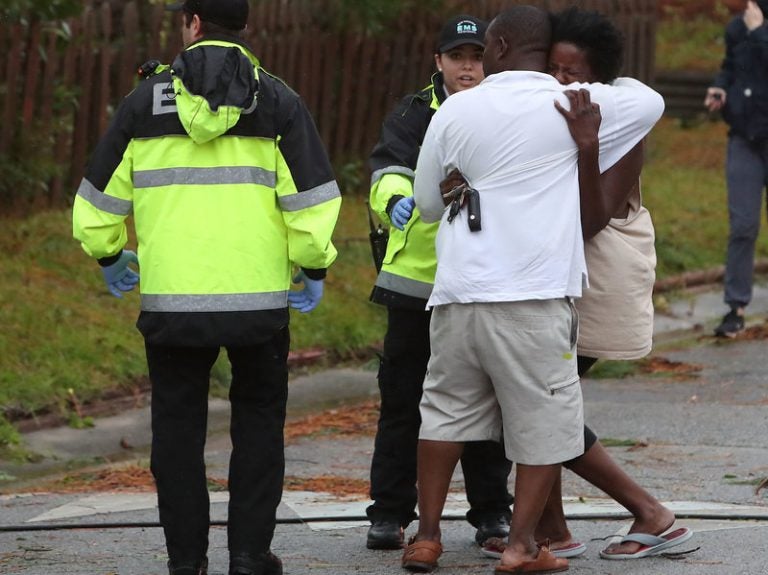
A woman reacts after a large tree fell on a house in Wilmington, N.C., as Hurricane Florence hit the area Friday. One man was taken out of the home in critical condition. (Mark Wilson/Getty Images)
Updated 4 p.m. ET
Hurricane Florence’s winds have diminished — but the slow-moving storm poses a dangerous threat to people in North and South Carolina, as its storm surge and intense rains bring high floodwaters to towns both on the coast and inland.
The storm has caused at least four deaths, a toll that is expected to climb. A woman and infant were killed in Wilmington, N.C., when a tree fell on their home, according to the local police department. Another victim of the storm died in North Carolina while plugging in a generator, the state’s governor says.
In Hampstead, N.C., a woman had a heart attack and debris in the roads prevented emergency responders from reaching her to provide care, a dispatcher confirms to member station NPR.
Florence has dumped more than a foot of rainwater on parts of southeastern North Carolina since making landfall near Wrightsville Beach at 7:15 a.m. ET.
The hurricane has moved at only 3-6 mph on Friday, increasing the effect of its torrential rains. As of 2 p.m. ET, Florence’s sustained winds dropped to 75 mph and it was slowly heading inland after wobbling along the coast, the National Hurricane Center said.
“Florence is an uninvited brute who doesn’t want to leave,” North Carolina Gov. Roy Cooper told NPR’s Morning Edition.
“We know we’re in for a long haul here,” Cooper said of predictions that the storm will linger all weekend. “But I think we’re ready.”
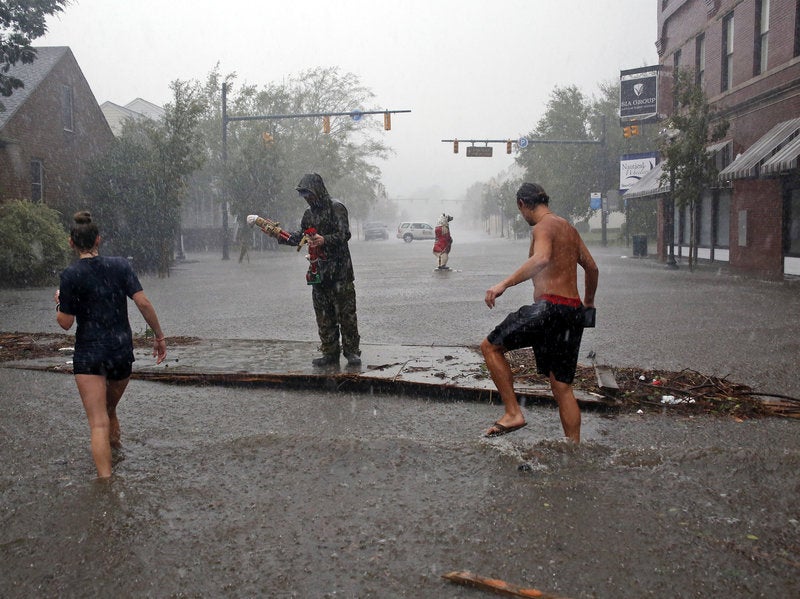
Florence remains a Category 1 storm, and it’s spinning hurricane-force winds up to 35 miles from its center. Tropical storm-force winds extend outward up to 170 miles, the hurricane center said.
“Some of the rainfall totals we’re getting are already adding up to about 14 inches,” NHC Director Ken Graham said shortly after 11 a.m. ET.
As of 1 p.m. ET, more than a foot of rain had fallen in many towns in southeastern North Carolina. Florence dumped more than 20 inches on Oriental, N.C., the NHC said.
Along the coast, floodwaters have been hitting inland towns near rivers that normally discharge into the ocean. But with a storm surge putting pressure on water to head back inland and heavy rains swelling those rivers, widespread flooding is the result. As Cooper said, “There’s nowhere for the water to go.”
Record water levels occurred at Wrightsville Beach, said NOAA’s Ocean Service, which reported the ocean “reached reached 4.11 ft above high tide, breaking a record set by Hurricane Joaquin in 2015 by more than a foot.”
Travel on the state’s roads has grown “extremely hazardous” and will get worse, said Jim Trogdon, the North Carolina transportation secretary.
“From Wilmington to Charlotte, we’ll experience between a 500-year and 1,000-year flood event,” Trogdon warned in a late-morning briefing.
The North Carolina State Highway Patrol says that as the hurricane hit the coast overnight, officers “responded to 108 calls for service and 30 collisions.”
The No. 1 mission right now, Cooper said, is to save lives.
“We’ve rescued over 100 people in New Bern, N.C.; people from Jacksonville, N.C., had to rescued from a hotel,” Cooper said, describing efforts to save people in towns north of Wilmington where high floods have already hit.
“We’ve got almost 20,000 people in 157 shelters,” Cooper said.
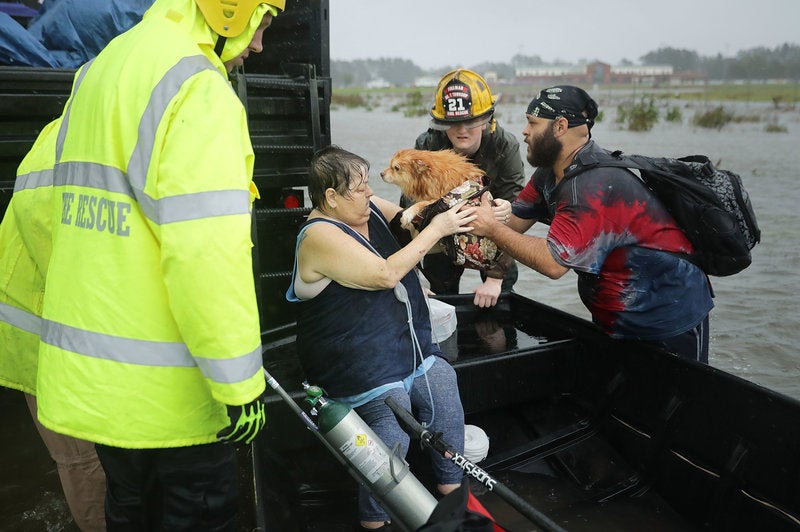
The hurricane has caused more than 615,000 power outages in North Carolina, with nearly 80,000 reported in South Carolina, according to website poweroutage.us.
As the power outages spread, federal authorities are warning of the risks of carbon monoxide poisoning, emphasizing that generators and grills should never be used indoors.
Florence’s eyewall reached shore near Wilmington, N.C., just before 6 a.m. ET Friday; more than an hour later, the National Hurricane Center announced, it had “finally” made landfall near Wrightsville Beach.
The news came more than 10 hours after the storm began punishing the coastal area with sustained hurricane-force winds, the hurricane center said.
In New Bern, Sarah Risty-Davis is one of the residents who opted not to follow a mandatory evacuation order that was issued three days ago.
“We had pretty high floodwaters up until the early morning hours,” Risty-Davis tells NPR’s Morning Edition. “I’m not sure if it’s a shift in the wind or low tide — but the water has miraculously disappeared.”
There’s still a threat from rising tides, Risty-Davis says. And she has seen reports of people fleeing to rooftops to escape high floodwaters.
Still, she said, “I think we’re going to stay put,” noting her neighborhood’s past success in avoiding power outages and flooding.
The storm surge that has hit New Bern is “approximately 2 feet higher” now than it was during Hurricane Irene seven years ago, the National Weather Service office in Morehead City says. The agency adds that people trapped by flooding should “never enter attics or crawl spaces.”
At the Wilmington airport, the wind was measured at 105 mph — the highest since 1958, Cooper said.
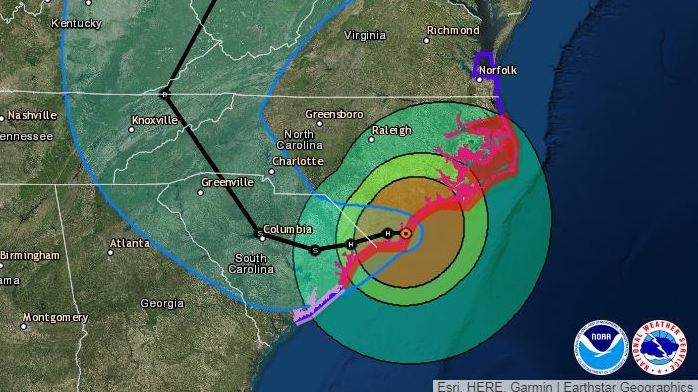
Florence arrived at the Carolina coast as a Category 1 storm, its 90-mph winds far slower than the fearsome 150 mph of just a few days ago. It will likely weaken more on Friday, with “rapid weakening forecast over the weekend,” the hurricane center said.
But forecasters say Florence’s biggest threat, as with all hurricanes, lies in its water: a storm surge of up to 11 feet and rainfall that will trigger catastrophic flooding.
Town of @HillsboroughGov had a landmark knocked over. The fallen red oak, one of the largest trees in town and thought to be over 200 years old, blocked Calvin Street and took out power lines but did not cause injuries or damage houses. pic.twitter.com/s3Ao1lqiXu
— WUNC (@wunc) September 14, 2018
“A USGS gauge in Emerald Isle, N.C., recently recorded 6.1 feet above normal water levels,” the National Hurricane Center said of the storm surge early Friday.
As it moves inland, the storm is expected to bring its high winds and intense rain bands across the southeastern corner of North Carolina and a large chunk of South Carolina. Rainfall of up to 20 to 40 inches could fall over the next five days in some areas, forecasters say.
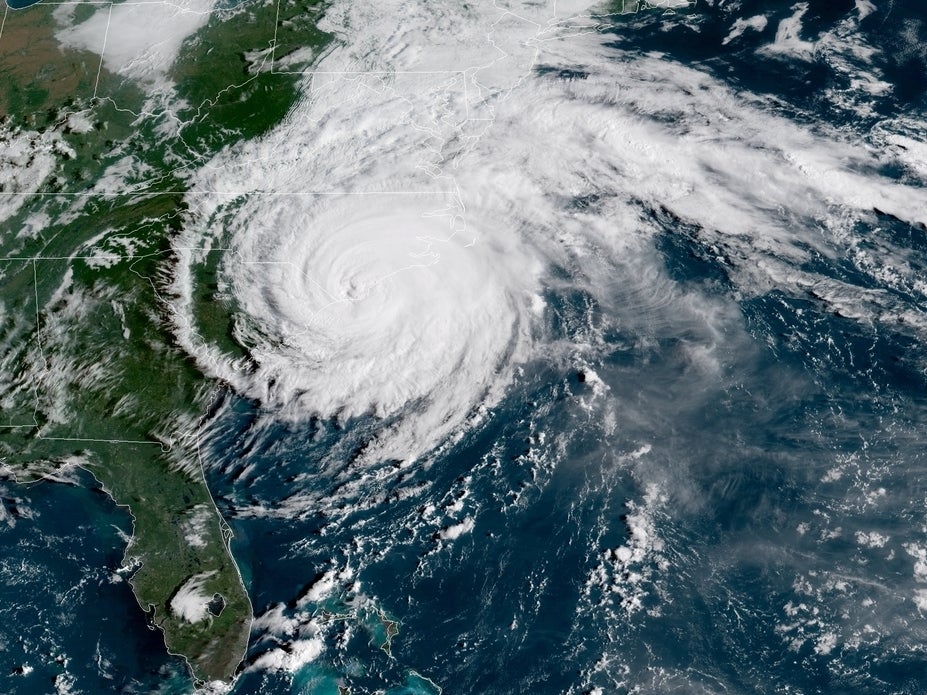
To prepare for this storm, businesses have been boarding up, and supplies have been readied for what is expected to be a large-scale relief operation. States of emergency have already been declared in both North and South Carolina. Thousands of soldiers from their National Guard forces have been mobilized.
Running Out Of Cots, North Carolina Shelters Strained As #HurricaneFlorence Hits https://t.co/t3cn8YNsht #ncwx pic.twitter.com/moppAuKqNZ
— WFAE (@WFAE) September 14, 2018
Whether residents left their homes, sought refuge in a shelter or are hunkering down, the weather service has bad news: After creeping inland, Florence “is expected to slow down even more today and tonight.”
By 2 p.m. Saturday, the storm won’t even be halfway across South Carolina, forecasters say. The fear is that during that slow march west, it’ll drop torrential rains, flooding low-lying areas and overwhelming rivers.
This landfall has been a long time coming: The hurricane arrived more than two weeks after the National Hurricane Center issued its first advisory for the storm. That advisory came out on Aug. 30, when Florence was developing near the Cabo Verde Islands across the Atlantic. Its designation then was “potential tropical cyclone six.”
Copyright 2018 NPR. To see more, visit http://www.npr.org/.9(MDAzMzI1ODY3MDEyMzkzOTE3NjIxNDg3MQ001))


